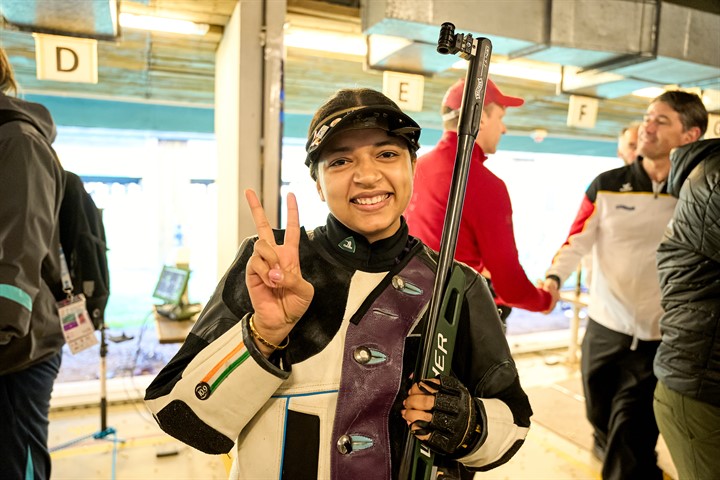
RevSportz Exclusive
A gold medallist in the Hangzhou Asian Games, India’s 50m 3P star, people had high expectations from Sift Kaur Samra for a podium finish in the Paris Olympics. However, an underwhelming qualification round didn’t get her through to the finals in Paris.
Now in the recently concluded ISSF Rifle/Pistol/Shotgun World Cup in Argentina and Peru, Sift won a gold medal in the Argentina leg – her first medal in a senior World Cup. Later, in Peru, a close margined competition didn’t make her the finals cut.
In this exclusive interview, she speaks on the campaign, ‘Standing’ – as her strongest suit in the 3P event, the International Olympic Committee’s (IOC) decision to have a ‘Standing-Only’ final in the 50m 3P event in the LA28 Olympics, her thoughts on youngsters like Suruchi Inder, her plans ahead and more.
Rohan Chowdhury: Your first senior World Cup medal and it’s a gold — how did it feel, and how would you describe your campaign in South America?
Sift Kaur Samra: It was a great competition, and Argentina was a completely new range for me. Winning gold there, at a new venue as my first senior World Cup medal, was a really proud and happy moment. I truly enjoyed it.
Rohan: What are the key takeaways from the South American World Cup?
Sift: One big takeaway for me was learning how to control the mind under those specific weather conditions.
I gained a lot of experience from both Argentina and Peru. Each had very different weather, and it was tough to adapt. But I think all the athletes performed really well despite the challenges.
Rohan: What actually happened in Peru? After the gold in Argentina, there was a sudden drop in scores. What was different about the conditions there?
Sift: Peru had an extremely windy range. Argentina was windy too, but in Peru, it was quite intense. That said, if you compare both venues, the scores were impacted similarly because of the wind. Since both are in South America, the weather was a common factor.
It wasn’t that I performed badly — I gave my best. In fact, all the athletes did. It was just one score that kept me out of the final. That’s how close and competitive it was.
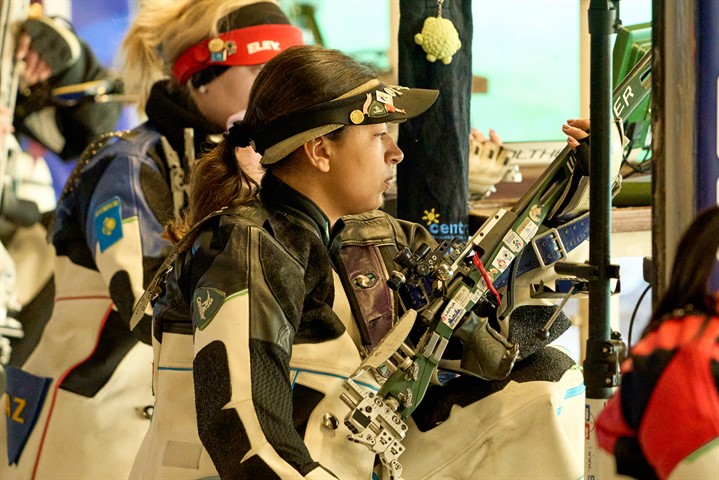
Rohan: Going back to Buenos Aires, you were in 8th place at the start of the standing series. But then, you accelerated and went on to win gold. What was going on in your mind at that moment?
Sift: My kneeling series wasn’t great. Normally, finals happen in a separate, closed hall — no wind, stable lighting. But in Argentina, there was no final hall. We shot the finals on the same open range as the qualification round. And by 4 PM, the conditions had changed — it was windy and getting darker. Plus, our range was behind the shotgun range, and due to the covering of the shotgun range, the 50m mark was a bit darker.
In kneeling, my position wasn’t perfect. Normally, you get two minutes to settle in after the introductions. But for this final, they told us last minute that we’d only have 30 seconds. I just couldn’t set up properly in that time.
But in prone, I knew I had to pull through. I was in 8th, and I told myself, ‘Don’t get eliminated at 8th. That would be very embarrassing’. So I pushed hard in prone, thinking even finishing 5th or 4th would be decent.
Then came standing. I kept telling myself, ‘You’re good at standing. You can do it’. I gave myself a positive pep talk and reminded myself it was just 15 shots. I’d done well in prone, and I could do it again.
Also, at the international level, not many athletes have a strong standing series like Indian shooters do. I focused on hitting consistent 10s and staying within the good scoring range, even if I got eliminated. Eventually, I found myself in the top 3 and reminded myself to just focus on the process and stay calm.
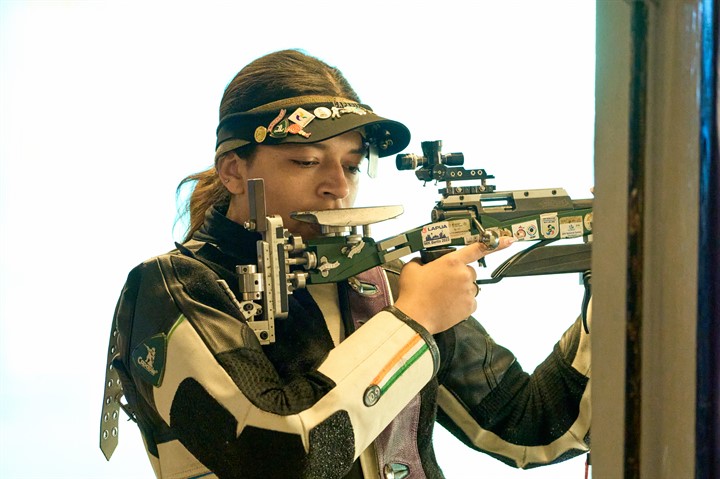
Rohan: Was there a moment when you realised you could win the gold?
Sift: Yes. There was a point when the shooter from Kazakhstan shot an 8 or 9, and I gained a two-point lead. That’s when I felt the momentum shift and believed I could go all the way.
Rohan: Would you say standing is your favourite position?
Sift: Definitely, yes.
Rohan: In previous competitions as well, you’ve accelerated during the standing series. That brings me to LA 2028 — the 50m 3P final will be standing-only. What was your reaction when the IOC announced this change, and what are your thoughts on it?
Sift: I was very happy. My teammates even came and congratulated me saying, “Standing-only finals — this is great news for you.” It’s a positive development, especially for Indian shooters. Not just me — Shriyanka (Sadangi), for example, is also really strong in standing.
That said, I can’t comment too much yet because we still don’t know the exact format — how many shots, the time allowed, and so on. We’ll need a couple of competitions under this new format to really understand it. Then I can give you a better perspective.
Rohan: You mentioned Shriyanka. If we look at this South American World Cup, we’ve seen a lot of promising young shooters like Suruchi (Singh Inder), Arya (Borse) and Simranpreet (Kaur Brar). What do you think the NRAI is doing right that’s leading to such a strong pool of young talent?
Sift: Suruchi is incredible — she’s a star in both her events. Watching her finals, I was honestly shocked by how confidently she shot, especially since it was her first World Cup. We were all so happy for her.
Usually, when young shooters win their first medal, they get nervous. But Suruchi had so much confidence and a great attitude. She played four tournaments and won three gold medals back-to-back — that’s phenomenal. I see her often because she trains at Karni Singh too. She wakes up early, comes to the range, shoots and heads back. That kind of commitment makes all the difference.
The same goes for Simran and Arya — the level of training and focus they bring is top-notch. And that quality training is showing results. These youngsters are more refined, and their presence is really helping strengthen the entire Indian contingent.
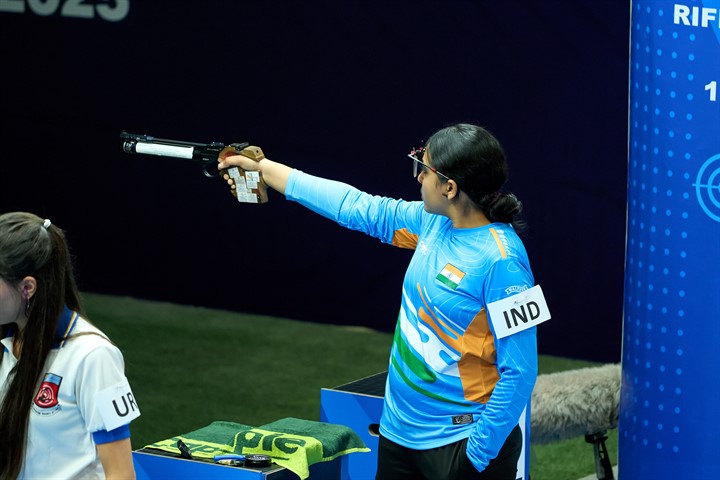
Rohan: On national trials — many top-level shooters, including Olympians, sometimes miss out on selection. The competition is very tough. What are your thoughts on the domestic circuit?
Sift: I was speaking to a foreign athlete once who said that in her country if you shoot a 28 in 10-metre, it’s considered excellent. But at the international level, even a 20 might not be enough.
I told her, in India, even if you shoot a 30, you might not make it. You have to shoot above 31 to be in contention. That’s how competitive it is.
But that’s a good thing. We have such a high standard and healthy competition in India itself that it prepares us for the international stage. You need to prove yourself, not just once but consistently. Only then do you make the team. That system really works for us.
Rohan: Did you get any time to explore Argentina and Peru outside of the competition?
Sift: Yes. We had some time after Argentina, around 4–5 days before heading to the Peru phase. During the training break, I got to visit Machu Picchu. We also explored around Lima and Buenos Aires. It was amazing — beautiful places and great memories along with the competition.
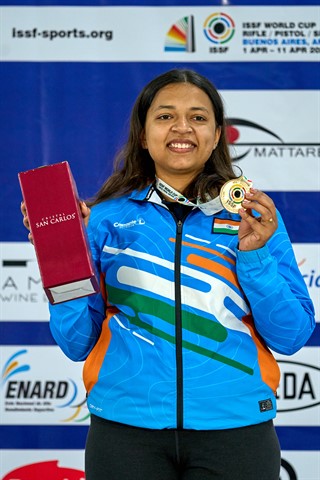
Rohan: Looking ahead, how are you planning your next few months? We have the Germany, Munich World Cup and then the national trials, leading up to the Asian and ultimately the World Championships.
Sift: The Munich World Cup is in June, so I have the full month of May to rest and train. After Munich, we return to India and will have just 1–2 days before the next round of trials for the Asian and World Championships.
We have the World Championship in Cairo and the Asian Championship in Kazakhstan, so the schedule is packed. But I’ve planned my recovery and workout sessions too.
This year, I really want to work on my kneeling. That’s the one area I want to improve so that what happened in Argentina doesn’t happen again. I also want to strengthen my standing even more to build a lead over others.
Rohan Chowdhury: Thank you so much, Sift. It was great talking to you. Congratulations again on your gold medal, and we look forward to more medals and more chats in the future.
Sift Kaur Samra: Thank you so much.
EXCLUSIVE @SiftkaurSamra 🗣️ “It’s a positive development, especially for Indian shooters. I was very happy” – on LA28’s 50m 3P ‘Standing-Only’ Finals, explains why.
She reflects on her @issf_official World Cup Argentina & Lima phase, thoughts on Suruchi Singh Inder, NRAI… pic.twitter.com/uiXDLIxGPT
— RevSportz Global (@RevSportzGlobal) April 25, 2025




